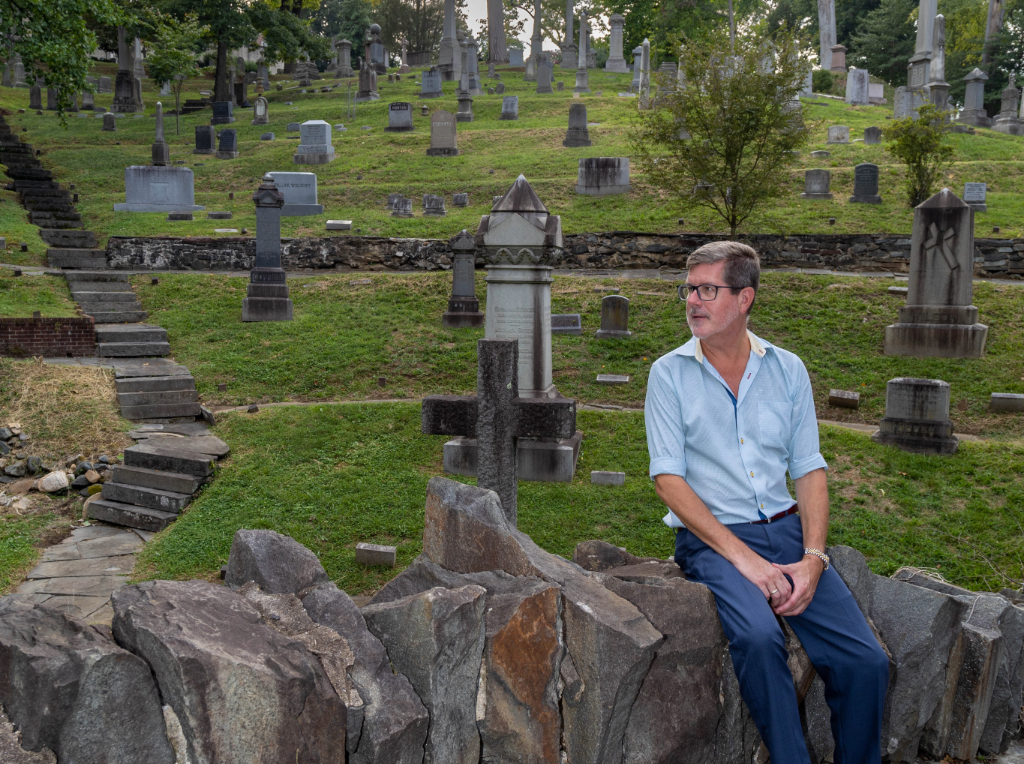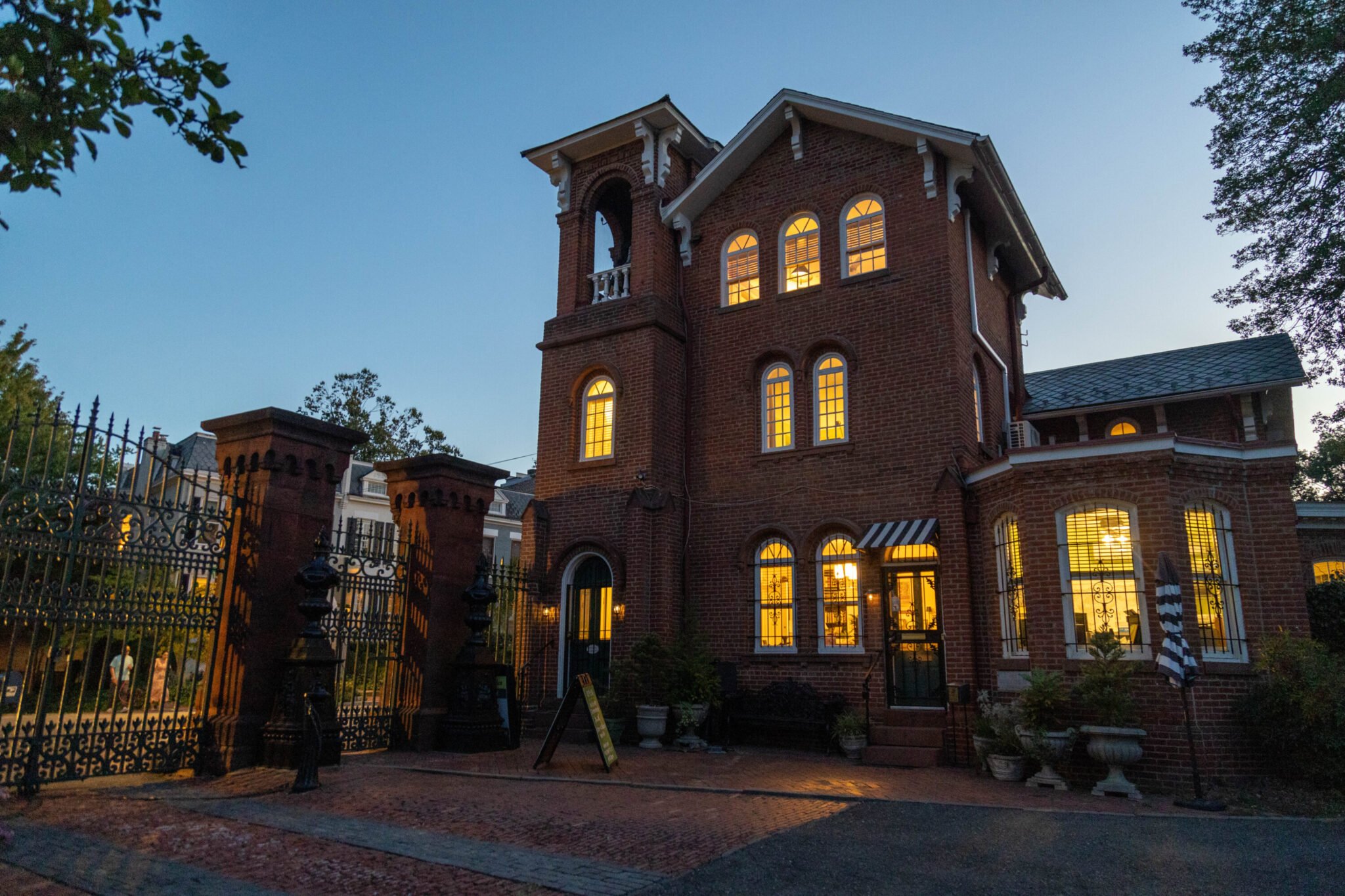Paul Williams is a regular middle-class guy who lives on a palatial Georgetown estate: 22 rambling acres nestled between Dumbarton Oaks and Rock Creek. His home is a red-brick 19th-century number, 5,500 square feet, with dark pine floors, arched windows, and a historic bell tower that tolls mournfully on the hour. To live there, Williams does not pay a cent. All he must do, essentially, is tend his lawn. It’s an exquisite expanse, laced with meandering paths, that’s home to a family of deer, a barn owl, and approximately 22,000 people—all of whom are dead.
The superintendent of Oak Hill Cemetery, Williams is a historic preservationist by trade, but he’s also part grief counselor, part nonprofit administrator, and part real-estate agent. One day he might scrub a white marble monument with a toothbrush, and the next he’ll oversee the burial of a local celeb. Jocular and unassuming, he wears this responsibility lightly. His favorite headstone inscription reads WE FINALLY FOUND A PLACE TO PARK IN GEORGETOWN! He likes to say that you can’t spell funeral without F-U-N.
Back in August, Williams and I hopped onto a golf cart to tool around the grounds of Oak Hill. It was a quiet weekday morning, clear and breezy, light dappling through the trees onto the grass. Atop a ridge, we passed a grand mausoleum that said BRADLEE, and I asked if that was Ben Bradlee, the longtime editor of the Washington Post. “Yeah, that’s him,” Williams said. “Sally Quinn comes every October and throws a little cocktail party. Isn’t that cute?”
Williams speaks of the dead in present tense. “That’s Arthur Cotton Moore,” he said as we zipped by a shiny metal monument that looked like a tree blowing sideways in the wind. “He’s a big architect in town. He designed the Georgetown waterfront and renovated the Library of Congress.” A moment later, he pointed toward a bundle of flowers. “Where that vase is, that’s Madeleine.” He meant Albright, the former Secretary of State.
Death, I learned at Oak Hill, is not the great equalizer. “There are egos involved in cemeteries,” Williams explained. “Some people want their name out there, big and bright and prominent, on the most expensive stone you can get. And other people—someone like Katharine Graham—may have huge name recognition and a lot of money but just a normal little stone and that’s it.” A while later, we passed a mausoleum belonging to a local lobbyist. “He’s still with us,” Williams clarified. “He’s alive.” Apparently, this man drops by regularly with his architect and landscapers, personally overseeing the build-out of his future home.
Death is very real to Paul Williams; he died once, just for a minute or so. He was tying down a sailboat when a bolt of lightning shot out of the sky and struck him.
Williams loves people like that: the ones who prepare years in advance of their deaths so that once the funeral arrives, everything is settled. “The worst drama is when there’s a recent death in the family and nobody made plans,” he said. “The person who died told nobody what they wanted done, so: ‘Did mom want to be cremated or a casket?’ ‘I don’t know.’ And then they get here and they start infighting. ‘Mom liked willow trees.’ ‘No, she didn’t, she liked cherry trees.’ And I’m like, oh God, here we go—and by the way, I need $75,000 in four days.”
The 75 grand is for a casket site; it’s the average cost to be buried at Oak Hill. A prime mausoleum spot costs ten times that much, three quarters of a mil just for the plot, plus another million or two to build the structure. On the lower end are cremation sites, columbarium niches, or even—for $500—ash-scattering off a hillside overlooking Rock Creek. “We try to have different levels of sites so that everybody has an opportunity to be here,” Williams said. “But we’re a high-end cemetery. We’re expensive.”
In discussing the money, Williams isn’t being crass. Site sales are the primary driver of Oak Hill’s revenue, and the thing about running a historic cemetery is that the maintenance needs are massive. There are 15,000 headstones to weed-eat around, acres of trees to be clipped. Last year, a windstorm blew through the grounds and knocked over 250 monuments; some of them need expert repairs. Decaying paths must be maintained. Someone mowed into a historic gate with their car. A 150-year-old mausoleum needs a $2 million restoration, and the cemetery has to foot the bill.
The way to generate revenue is to sell casket and cremation sites. If Williams isn’t slinging plots, his beloved cemetery can’t afford to run.

Death is very real to Paul Williams; he died once, just for a minute or so. It was 2001, and he was tying down a sailboat in Fort Washington when a bolt of lightning shot out of the sky and struck him. His injuries were grave. “It changes your whole perspective when you’re told by a doctor that you shouldn’t have survived this,” he said. One effect is that life’s value becomes apparent. Another is that he’s become pretty matter-of-fact about death.
Dispositonally, that’s perfect for running a cemetery, though it’s not what Williams first set out to do. As a kid in upstate New York, repairing a tumbledown Victorian with his dad, he fell in love with old houses—and he later made a living doing genealogies of historic homes in DC. Then, in 2012, he got a job running Congressional Cemetery. He had fun with it, starting its nighttime “Soul Strolls” tours and organizing movie nights and 5K races. In 2021, when a vacancy opened up at Oak Hill, he pounced. “I said, ‘I’d get to live in Georgetown? For free?’ ”
When he arrived in that job, a core duty was to solve a math problem, one that many historic cemeteries face: Oak Hill’s acreage is finite, but the cemetery still inters about a hundred bodies a year. Because of that, it has run slightly thin on plots. “We’ve gotten really creative to make new real estate,” Williams said, pointing to a simple slate path that snaked up a steep hillside between graves. Buried under that path are urns. “Some people love it—they say, ‘I’d love to be walked on.’ Others are like, ‘No, that’s not for me. No way.’ ”
As we wheeled around a corner, Williams pointed out another way he’s creating real estate. A stretch of landscaping fabric lay over the bare ground; his crew, he explained, had ripped out the path—an “awful old asphalt one from the 1940s”—then leveled the earth, laid down burlap to grow grass, and installed a gutter for water runoff. This probably created another 50 traditional casket sites (grass, headstone), almost $4 million in possible sales.
Half of that money will be used to feed the cemetery’s operations—salaries for the grounds crew, materials for building and landscaping—while the other half goes into Oak Hill’s endowment, which will allow the cemetery to be maintained, in perpetuity, once it’s full. Williams estimates that will come in about a century, at which point it will likely become a museum—part park, part sculpture garden, and part celebration of, as Williams says, the hordes of significant locals for whom Oak Hill is their “final forwarding address.”
Today, the cemetery’s biggest historical draw is a boy who no longer resides there. From 1862 to 1865, Abraham Lincoln’s young son Willie—dead at age 11 of typhoid fever—was interred in a mausoleum overlooking Rock Creek. When Lincoln was shot, Willie’s remains accompanied his father’s to Illinois, but the mausoleum is still a destination, a huge driver of visits to Oak Hill.

I asked Williams to take me there, so we parked the golf cart and descended a steep stone staircase. “It’s so popular, but it’s the most difficult mausoleum to find,” he said, “way down there in the lowest edges. It’s a precarious hike.” To our right, an almost vertical hillside tumbled down into Rock Creek, and at the very end of a tree-shaded path, right up against a fence, was the stone edifice belonging to William Carroll, a former clerk of the Supreme Court, who lent space to the Lincolns when Willie died. During the height of the Civil War, the grieving President would apparently ride to the cemetery on horseback and sit inside the mausoleum at night, holding his son’s remains.
Williams pushed open the wrought-iron gate—“It’s kind of cool that when you open it, you know Lincoln’s hand was in the same place”—and we stood for a moment inside, weak light filtering against a wall of dusty, cracked casket bays, dried leaves and a scattering of pennies around our feet. Lincoln’s face is on the penny, Williams explained; aficionados leave them, like they’ve made a pilgrimage to a shrine.
As Williams and I wrapped our tour, a man and woman—middle-aged, drawn faces—were lingering outside the gatehouse. Williams asked what they needed, and the woman paused. “Our son died two months ago, so we’re looking for a plot for him, and also for us.” Williams was friendly and pragmatic, not somber, as he laid out the options, then pointed them toward a few areas where there’s space. Immediately, the bell above the gatehouse began to clang noon.
“I think it’s a coping mechanism,” Williams said of his refusal to be gloom-and-doom about death. But it also puts people at ease. Oftentimes, when he’s selling gravesites, the future decedent will lie down on the ground to get a sense of the view. “I interject some humor with that,” Williams told me. “I’m like, ‘You know, you’re not going to see that tree, you’re going to be six feet down.’ ” Afterward, he said, they tend to relax. “I get a lot of feedback that I made what could be a gruesome, depressing process kind of enjoyable and entertaining.”
Death is not imminent for Williams—he’s 58—but a perk of his job, in addition to living rent-free in the gatehouse, is that he and his husband will be housed gratis once they’re dead. He loves the idea of resting at Oak Hill, among the bubbling fountains and historical stones, right in their own backyard. Soon, he and his husband will pick a site.
As the cemetery’s keeper, Williams turns out to be fairly indifferent to its highestdollar real estate: the huge plots with sweeping views, the imposing mausoleums. “I like the valleys,” he said, “the curving paths and the big old trees with all the birds in them and water running down the little gullies.” He wants to rest in a plain pine box, beneath a simple headstone with Doric columns, and he imagines wildlife—deer and foxes, the occasional wild turkey—scampering above his and his husband’s heads.
Williams discusses these plans fluidly, without a trace of vexation—the same way he describes repairing an ornate headstone, or the rehabilitated squirrels that the city releases into his trees. “You get used to it,” he said of death. “I’m happy to be here, and I’m sad when people die, but at the same time, it’s just the life cycle. We’re not dead yet, so let’s just keep it light.”
This article appears in the October 2024 issue of Washingtonian.



















